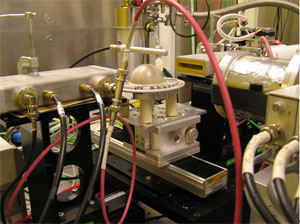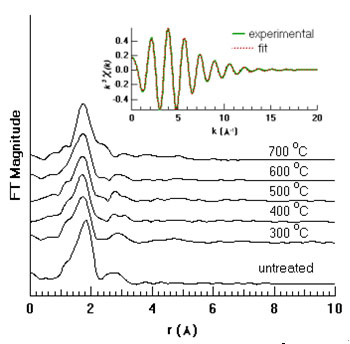
Structurally incorporated impurities have been shown to have systematic effects
on the rate of the thermally driven transformation in titania nanoparticles [1-4]. The anatase-to-rutile transformation is
slowed when anatase nanoparticles are doped with a cation of valence > +4, but
favored when the valence < +4. Based on these observations, Y3+
dopants should promote the anatase-to-rutile transformation. However, prior
studies showed that the transformation is inhibited by Y3+
impurities [1,2], without explaining this
observation. In a study led by the scientists of University of California
Berkeley and Lawrence Berkeley National Laboratory, extended x-ray absorption
fine structure (EXAFS) experiments on yttrium-doped titania nanoparticles were
conducted for determining the local structural environment of Y3+
impurities. The experiments were developed in collaboration with SSRL beamline
scientists at BLs 10-2 and 11-2.
 |
Figure 1:
The EXAFS experimental setup. A Si(220) crystal was used in the monochromator
with an energy resolution of about 1 eV. Sample powders were brushed onto
sticky Kapton tape.
| |
EXAFS setup is shown in Figure 1. The measurements at the Y K-edge (17300 eV)
were made up to k = 12 Å-1. A Lytle detector was used with
helium gas flowing through the sample chamber and Ar gas through the detector
chamber. The x-ray energy was calibrated with Y foil before the experiments.
For harmonics rejection the monochromator was detuned by 50%. Because the
doping concentration of yttrium is relatively low, fluorescence mode was used.
The fit results (Figure 2) indicate that the Y impurity does not exist as
(Y¬xTi)O2-3x/2, i.e., the Y impurity is not
structurally incorporated. This differs from the cases of doping
TiO2 with some other ions (e.g. Cr3+, Fe3+),
where impurities are distributed within the nanoparticles [2,3]. The reason why Y3+ does not
substitute for Ti4+ in TiO2 nanoparticles is very likely
the difference in the size of the Y3+ (0.892 Å to 1.10 Å) and
Ti4+ ions (0.53 Å to 0.605 Å) [5]. Moreover, the
first shell scattering in the EXAFS data is well fitted by Y-O bonds of length
~ 2.3 Å, a nearly 20% mismatch with the Ti-O bond lengths in the nanoparticles
(1.92 Å and 1.96 Å) [6]. For heat-treated nanoparticles, the
first shell Y-O coordination number is six, consistent with the yttrium oxide
(Y2O3) structure. However, the characteristic XRD peaks
of Y2O3 are not detected from our samples indicating
that, if present, individual clusters of this phase should be smaller than ~1
 |
Figure 2:
Fourier transform magnitude of k3-weighted Y K-edge EXAFS spectra of
yttrium-doped TiO2 nanoparticles as a function of treatment
temperature. Inset: A representative one of the k3-weighted
first-shell EXAFS spectra (solid green line) and the fit (dashed red line).
| |
nm. Furthermore, the Y-O bond length (~2.3 Å) is larger than that of bulk
Y2O3 (2.2749 Å) [7]. It can be conclude
that yttrium impurities are mostly present as individual, oxygen-coordinated
atoms at the titania surface (i.e., as YO6 groups) and about 15% of
the surface oxygen sites are bound to Y.
Together with the observation of the structural modification and phase
transformation retardation in the complementary wide-angle x-ray scattering
experiments for the study, it has been found that the low concentrations of
yttrium surface impurities on nano-anatase reduce surface energy and inhibit
nanoparticle growth over a large temperature range. As a consequence, the
anatase phase is also stabilized, as the anatase-to-rutile transformation does
not occur below 700 °C. The findings demonstrate the effectiveness of surface
bound impurities of stabilizing nanoparticle size and phase, an issue of great
importance for retaining the materials properties of nanoscale catalysts that
operate at high temperatures.
Primary Citation
Bin Chen, Hengzhong Zhang, Benjamin Gilbert, Jillian F. Banfield, "Mechanism
of Inhibition of Nanoparticle Growth and Phase Transformation by Surface
Impurities", Phys. Rev. Lett. 98, 106103 (2007).
References
-
J. F. Banfield, B. L. Bischoff, and M.A. Anderson, Chem. Geo. 110, 211 (1993)
-
B. L. Bischoff, Thermal Stabilization of Anatase Membranes, Ph.D. dissertation,
University of Wisconsin-Madison, 1992.
-
Y. H. Zhang, and A. Reller, J. Mater. Chem. 11, 2537 (2001).
-
H. Yamashita et al., J. Synchrotron Rad. 6, 451 (1999).
-
F. D. Bloss, Crystallography and Crystal Chemistry (Holt, Rinehart and Winston,
New York, 1971).
-
L. X. Chen et al., J. Phys. Chem. B 101, 10688 (1997).
-
N. Thromat et al., Phys. Rev. B 44, 7904 (1991).
|
| PDF
Version | | Lay Summary | |
Highlights Archive
|
| SSRL is supported
by the Department of Energy, Office of Basic Energy Sciences. The SSRL
Structural Molecular Biology Program is supported by the Department of Energy,
Office of Biological and Environmental Research, and by the National Institutes
of Health, National Center for Research Resources, Biomedical Technology
Program, and the National Institute of General Medical Sciences. |
|



